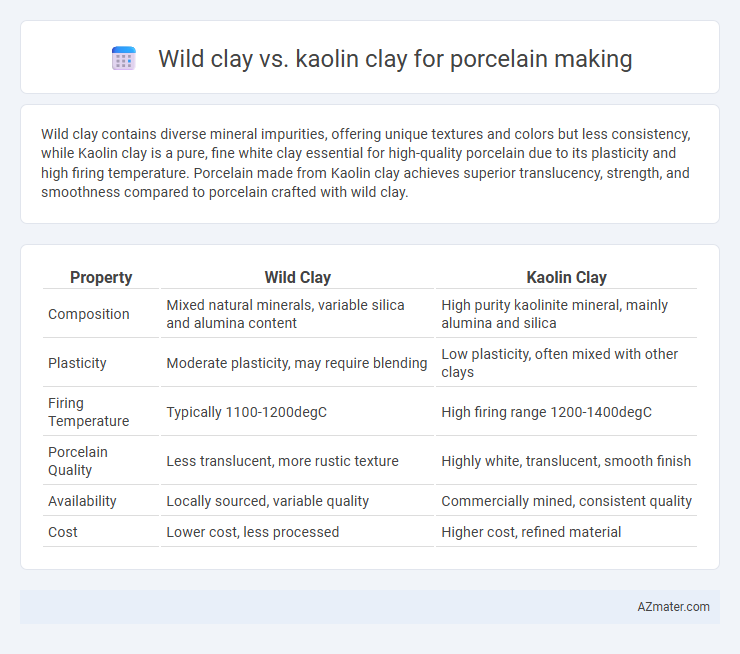Wild clay contains diverse mineral impurities, offering unique textures and colors but less consistency, while Kaolin clay is a pure, fine white clay essential for high-quality porcelain due to its plasticity and high firing temperature. Porcelain made from Kaolin clay achieves superior translucency, strength, and smoothness compared to porcelain crafted with wild clay.
Table of Comparison
| Property | Wild Clay | Kaolin Clay |
|---|---|---|
| Composition | Mixed natural minerals, variable silica and alumina content | High purity kaolinite mineral, mainly alumina and silica |
| Plasticity | Moderate plasticity, may require blending | Low plasticity, often mixed with other clays |
| Firing Temperature | Typically 1100-1200degC | High firing range 1200-1400degC |
| Porcelain Quality | Less translucent, more rustic texture | Highly white, translucent, smooth finish |
| Availability | Locally sourced, variable quality | Commercially mined, consistent quality |
| Cost | Lower cost, less processed | Higher cost, refined material |
Understanding Wild Clay and Kaolin Clay
Wild clay contains a mix of minerals and impurities that influence its plasticity and firing properties, making it less predictable for porcelain production, whereas kaolin clay is composed primarily of pure, fine-grained kaolinite, known for its whiteness, purity, and high refractory strength essential for high-quality porcelain. Kaolin's low iron content and particle size contribute to its translucency and smooth finish in fired porcelain, whereas wild clay's variability can affect color and texture outcomes. Understanding these compositional differences helps potters select kaolin clay for consistency and purity or wild clay for unique, rustic aesthetics in porcelain making.
Key Differences in Mineral Composition
Wild clay typically contains a mix of minerals including illite, montmorillonite, and a variety of impurities, resulting in a less uniform composition compared to Kaolin clay. Kaolin clay, also known as china clay, is primarily composed of the mineral kaolinite, which is a pure, fine-grained aluminosilicate with minimal impurities, making it ideal for producing high-quality porcelain. The high kaolinite content in Kaolin clay ensures better plasticity, whiteness, and firing properties essential for thin, translucent porcelain pieces, whereas wild clay's heterogeneous mineral content often leads to darker colors and lower vitrification.
Sourcing and Processing: Wild Clay vs. Kaolin
Wild clay is sourced from natural deposits often found in riverbeds and forested areas, requiring minimal processing but variable purity, which affects the consistency of porcelain products. Kaolin, a pure white clay sourced primarily from kaolin-rich deposits like those in China and the southeastern United States, undergoes extensive purification and refining to remove impurities for high-quality porcelain. The controlled processing of kaolin enhances its plasticity and whiteness, making it the preferred material for fine porcelain compared to the more rustic, less predictable nature of wild clay.
Plasticity and Workability in Porcelain Bodies
Wild clay exhibits higher plasticity compared to kaolin clay, making it more flexible and easier to shape in porcelain bodies. Kaolin clay, while less plastic, contributes to a smoother texture and greater whiteness in finished porcelain, but requires blending with more plastic clays to enhance workability. Combining wild clay's plasticity with kaolin's purity optimizes the balance of shaping ease and final porcelain strength.
Firing Temperatures and Maturation
Wild clay typically matures at a higher firing temperature range, often between 1250degC and 1300degC, making it suitable for stoneware and high-fired porcelain. Kaolin clay, known for its purity and whiteness, requires a slightly lower maturation temperature, around 1200degC to 1250degC, producing a translucent and delicate porcelain body. The higher alumina content in kaolin enhances its vitrification process at these temperatures, resulting in a smoother and more refined porcelain compared to the more variable composition of wild clay.
Color and Texture Outcomes in Finished Porcelain
Wild clay often results in porcelain with a richer, more varied color palette due to its natural mineral content, providing earthy tones and subtle speckles. Kaolin clay, prized for its high purity, produces a smoother texture and a bright white finish, essential for the classic clean look of fine porcelain. The higher plasticity and fewer impurities in kaolin contribute to a more refined, delicate surface texture, which enhances translucency and overall aesthetic quality in finished porcelain pieces.
Strength and Durability Comparisons
Wild clay contains a diverse mineral composition that often results in stronger, more resilient porcelain due to its increased natural impurities acting as reinforcing agents. Kaolin clay, prized for its purity and fine particle size, produces porcelain known for its smooth texture but generally has lower mechanical strength compared to wild clay variants. Porcelain made from wild clay typically exhibits superior durability and resistance to fracturing under stress, making it ideal for applications requiring enhanced toughness.
Environmental Impact of Clay Sourcing
Wild clay sourcing often involves minimal environmental disturbance due to its natural occurrence on the surface, reducing the need for extensive excavation. Kaolin clay extraction typically requires open-pit mining, which can lead to significant landscape alteration, habitat disruption, and increased energy consumption. Sustainable sourcing practices and reclamation efforts are critical to minimizing the environmental footprint of both wild and kaolin clay in porcelain production.
Cost Considerations for Porcelain Creation
Wild clay typically offers a lower cost option for porcelain making due to its natural abundance and minimal processing requirements, making it attractive for budget-conscious artisans. Kaolin clay, essential for high-quality porcelain, tends to be more expensive because of its refined purity, consistency, and crucial role in achieving the desired translucency and strength. Choosing between wild clay and kaolin involves balancing raw material costs against the quality and performance demands of the final porcelain product.
Choosing the Right Clay for Your Studio Practice
Choosing the right clay for porcelain making involves understanding the distinct properties of wild clay and kaolin clay. Wild clay offers natural mineral diversity that can enhance texture but may introduce impurities affecting translucency and strength. In contrast, kaolin clay is prized for its high purity, whiteness, and plasticity, making it ideal for producing delicate, high-quality porcelain pieces in a studio setting.

Infographic: Wild clay vs Kaolin clay for Porcelain making
 azmater.com
azmater.com